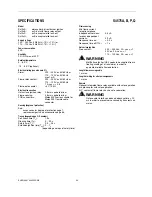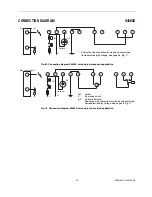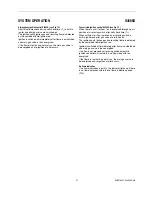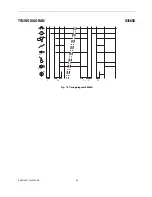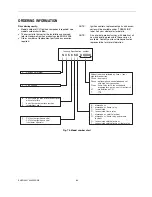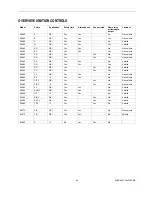
61
EN2R-9031 0402R15-NE
ELECTRICAL CONNECTIONS AND WIRING
IMPORTANT
Take care that installer is a trained experienced
service person.
Disconnect power supply to prevent electrical shock
and/or equipment damage.
Turn off gas supply before starting installation.
Wiring must be in accordance with local regulations.
The appliance manufacturer’s instructions should
always be followed.
Before installing or replacing any control check that
type number is correct for the application.
Ensure combustion chamber is free of gas before
start up.
Conduct a thorough check out when installation is
completed.
At the first start the ignition controller can be in lock
out; depress reset button to free control.
CAUTION
Do not connect the ignition control to power supply
when it is not connected to the gas control.
Wiring
•
Use cable which can withstand 105°C ambient.
•
Use cable which is proven against moisture.
•
Wiring between ignition control and spark sensing probe
should have good quality insulation, suitable for the
temperatures encountered.
CAUTION
CAUTION
If ignition frequency q 25 Hz or pulse energy
> 45
µ
As the ignition cable and its connections shall
have a protection against electrical shock hazard.
For single rod applications, the ignition/sensing cable
and its connections shall have protection against
electrical shock hazard.
Label all wires prior to disconnection when servicing
ignition controls. Wiring errors can cause improper
and dangerous operation.
If electronics components are installed in an area
subject to water (dripping, spraying, rain etc.), means
shall be provided to protect these components.
Flame relay output is not accessible when the
normally closed output is present.
Fusing
In order to prevent unsafe conditions at too high current, the
ignition controls have an integral non replaceable fuse.
This fuse will be blown long before the maximum 16 A
external fuse switches off.
Spark gap
Max. allowable spark gap 3.5 mm
Supply voltage polarity
WARNING
If ignition control
(without the phase neutral
independent operation feature)
seems to operate
normally but does not detect flame, check for right
polarity of power supply (line, neutral).
Checking flame current
•
The minimum value should be in accordance with
specified value.
•
To check flame current connect a dc micro-Ampèremeter
between flame sensing wire and flame sensing rod.
•
Meter connections polluted with e.g. alkaline substances
lying close to earth can cause flame current simulation.
Make sure no false flame current can flow from meter
connections to earth.
•
If flame current is insufficient check that the flame sensing
rod is fully enveloped by the flame and that burner and
ignition control are reliable grounded.
•
If there is no sufficient flame current due to phase-phase
mains it is recommended to use an ignition control with the
phase neutral independent operation feature. If this is not
available, it is recommended to use a AT7030A or
AT7030B flame detection transformer. See also instruction
sheet EN1R-9136 for the AT7030 transformer.
Flame sensing wiring
The S4565/S4575 and S4585 ignition controls are equiped
with flame sensing by ionisation current based on the flame
rectification principle.
Via a high ohmic source a high voltage is applied to the flame
rod.
Because of the high impedance the flame rod connection is
safely accesible according to EN 60730.
Since the flame sensing input is very sensitive and the
current detection threshold is only a few tenths of microamp,
care must be taken that no spurious current flows.
The flame rod wire must have creepage to earth of at least 10
mm.
Contacts of the flame rod wire must not be imposed to fluids
or dirt.
Short
µ
A meter during ignition, to prevent damage of
the
µ
A meter in single rod application.
WARNING




